The Pentacon Six System
by TRA
Exakta 66 Bellows
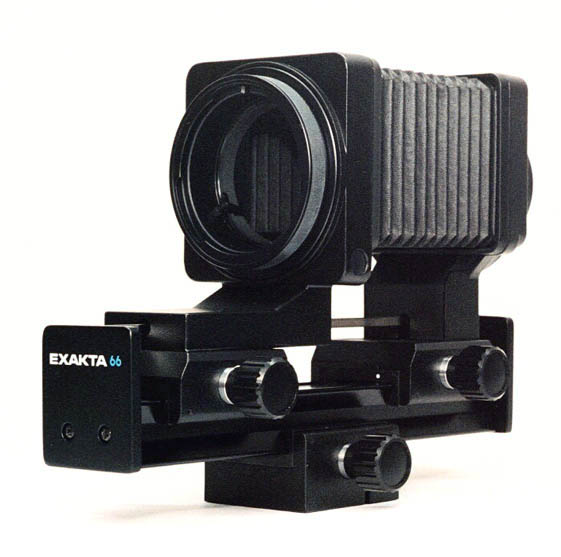 [C309-16aE66B: The Exakta 66 bellows unit]
[C309-16aE66B: The Exakta 66 bellows unit]
|
|
For their bellows, Exakta/Schneider have improved on the Pentacon Six
model in a number of areas. One can immediately see that the smart,
square-section design is less bulky. The Exakta 66 bellows extension
is much longer than the Pentacon Six bellows extension – although this
can of course be increased by the use of extension tubes. The Exakta
66 bellows also incorporate an excellent and very long focussing slide.
(A much shorter focussing slide can be added to the Pentacon Six bellows.)
This slide is extremely helpful for fine focussing with the camera mounted
on a tripod.
With the Joseph Schneider Exakta 66 bellows, both front and rear standards
move, and lock. Only the front standard moves with the Pentacon Six
(in practice I do not see this as a limitation), and it does not lock,
although it is well held in place by friction.
|
| Advantages of the Exakta
66 bellows
For extreme macro work, the Exakta 66 bellows with built-in focussing
slide is far superior in most respects to the Pentacon Six bellows with
Pentacon focussing slide. This is for the following reason:
with the Exakta 66 bellows and focussing slide there is a toothed drive
with a drive control knob for each of the three functions:
-
front standard of bellows
-
rear standard of bellows
-
focussing slide.
On the other side of the bellows there is a locking knob corresponding
to each of the drive control knobs. This makes precise focus and
distance adjustment much easier to achieve.
Comparison with the Pentacon
Six bellows and focussing slide
With the Pentacon Six bellows there is a drive knob (to vary the bellows
extension) on each side of the bellows, but no locking knob. The
chosen setting is held in place by friction, and this seems to work quite
well. The focussing slide does not have a drive knob; setting can
only be changed by pushing the top of the slide (which holds the camera)
to and fro, and then locking it in the chosen position with the locking
knob.
When working with the unit in horizontal position, this works quite
well. But for copying work with the bellows used vertically, adjustments
can be extremely difficult, especially with the most powerful of the macro
lenses, the 28mm M – Componon.
Image to the right: Underside view of the Exakta 66 bellows. The
three drive control knobs are on the right in this photo, and the locking
knobs are on the left. Note the attention to detail by the designers,
who provided ¼" and 3/8" sockets for use with tripods and copying
stands. [e66bell2.jpg]
|
|
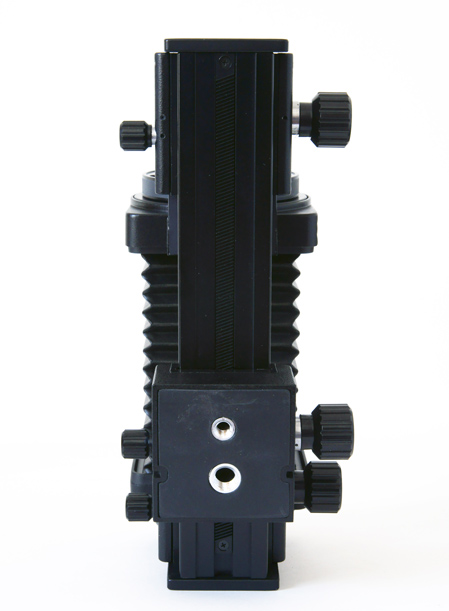 |
| Other features of the Exakta
66 bellows
Unlike the Pentacon Six bellows, the unit from Schneider/Exakta does
not require a double cable release, as a rod running the length of the
bellows connects the rear pin that is activated by the camera with a lever
at the front that connects with the pin on the lens.
Of course, the Pentacon reversing tube can be used on the Exakta 66
bellows, with an adapter ring if using Exakta lenses, most of which have
a filter thread of 67mm. In this case, the special Pentacon aperture
control ring and double cable release can be used to maintain automatic
diaphragm operation.
However, in spite of what is stated in the Exakta 66 publicity, it is
not
possible to transfer aperture values to the Exakta 66 TTL prism, nor is
it possible to meter in the normal way (full aperture metering) – although
I can do stop-down metering with the Kiev 60 TTL prism on a Kiev 60 or
Exakta 66, and I can do stop-down metering on a Pentacon Six with its TTL
prism or the Kiev 60 prism (see the section on other
accessories).
Two pins on the rear of the bellows (see illustration below) depress
two contacts on the Exakta 66 metering prism, which allegedly switches
this to stop-down metering. I have yet to test this function.
| See more details of how the Exakta 66 meter works here. |
To go to the beginning of the report on the macro lenses, click here.
To go straight to the report on using the Schneider macro lenses with
the Exakta 66 bellows, click here.
|
|
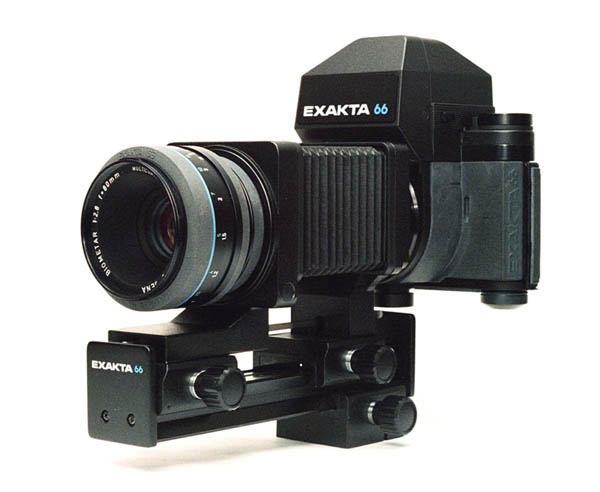 [C309-19a: The Exakta 66 camera and bellows.
[C309-19a: The Exakta 66 camera and bellows.
The integrated focussing slide is the block under the main runners.]
|
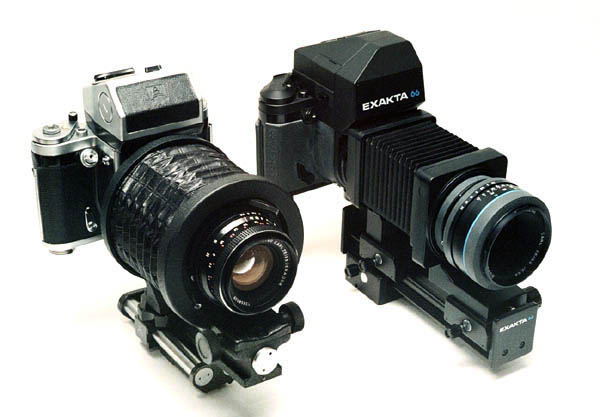
[C309-22a: The Pentacon Six and Exakta 66, each with its bellows
unit.]
Compatibility
Lenses
Pentacon Six (Carl Zeiss Jena) lenses work fine on the Exakta 66 bellows,
and so do Arsenal lenses.
However, one word of caution is in order concerning the Arsenal 80mm
Volna or Arsat lens. This focusses much closer than the Pentacon
Six and Exakta 66 standard lenses, but when focussing the lens closer than
a meter, a design fault may become evident: light may enter the rear
of the lens via the opening for the stop-down lever. This is not
really a compatibility problem, since it occurs regardless whether or not
bellows are used, and regardless of the camera body in use. There
are two possible solutions:
do not focus closer than 1 meter (!); use an extension tube or bellows
instead;
cover the stop down lever with masking tape, after having used it if necessary
for metering.
Bodies
There is a slight degree of incompatibility: the pin on the rear of
the Exakta 66 bellows is slightly too short to open up any lens fully when
the bellows unit is used on the Kiev 60, because it is not adequately depressed
by the lever in the throat of the Kiev 60. It works fine on the Exakta
66 and the Pentacon Six. It is possible to adjust the Kiev 60 diaphragm
lever, although this should be done with caution, as problems may then
arise getting some lenses to stop down adequately. A lot of patient
experimentation is called for, and given those tolerance lattitudes, it
could be slightly different for each Kiev 60 or each set of Arsenal lenses.
The TTL metering stop-down pins on the back of the Exakta 66 bellows
prevent the bellows from being mounted on my Kiev “B.i.g.” – although this
can easily be overcome by the use of a short extension tube between the
bellows and the body.
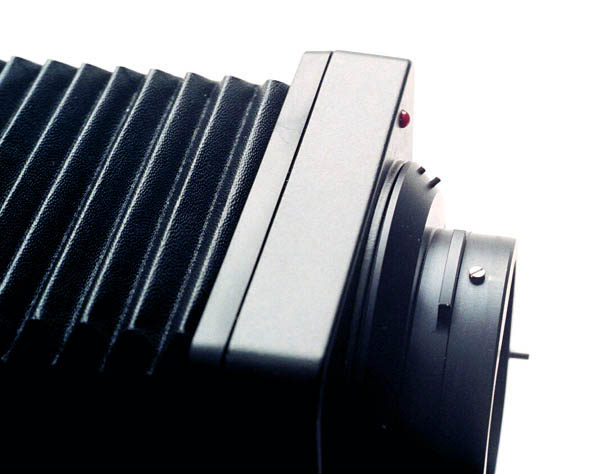
[C311-14: top-right in this view of the bellows mount to the camera
body:
the two small pins prevent mounting the bellows directly
onto my Kiev 88-6 / Kiev “B.i.G.”]
For a description of stop-down metering with the Exakta 66 TTL prism,
click
here and scroll down. I need
to investigate further the operation of stop-down metering on the Exakta
66, and plan to report on this website when I know the answers.

[C311-13: The Exakta 66 bellows being used on the Kiev “B.i.G.”
with a short Pentacon tube mounted on the camera body.]
Schneider produced four of its already-famous lenses in the Exakta 66
mount, for use on the bellows only. To read a report on these lenses
click here.
To go back to the beginning of the macro section, click here.
To go on to the next section, click below.
Next section (Novoflex Bellows)
To go back to the beginning of the Accessories section, click below
and then choose the accessory that you want to read about.
Back to beginning of the Accessories section
Home
© TRA February 2002, July 2011





